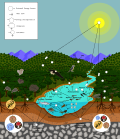The competitive Lotka–Volterra equations are a simple model of the population dynamics of species competing for some common resource. They can be further...
21 KB (3,114 words) - 15:07, 27 August 2024
The Lotka–Volterra equations, also known as the Lotka–Volterra predator–prey model, are a pair of first-order nonlinear differential equations, frequently...
34 KB (4,494 words) - 18:22, 12 June 2025
generalized Lotka–Volterra equations are a set of equations which are more general than either the competitive or predator–prey examples of Lotka–Volterra types...
12 KB (1,821 words) - 15:43, 26 May 2025
The random generalized Lotka–Volterra model (rGLV) is an ecological model and random set of coupled ordinary differential equations where the parameters...
15 KB (2,056 words) - 14:08, 26 May 2025
have been formalized in a mathematical model called the Competitive Lotka–Volterra equations, which creates a theoretical prediction of interactions....
25 KB (3,349 words) - 04:36, 2 June 2025
presence of one aids the population growth of the other. See Competitive Lotka–Volterra equations for further extensions of this model. Unified neutral theory...
61 KB (7,435 words) - 05:48, 7 June 2025
Population model (section Equations)
growth equation: d N d t = r N ( 1 − N K ) {\displaystyle {\frac {dN}{dt}}=rN\left(1-{\frac {N}{K}}\right)\,} Competitive Lotka–Volterra equations: d N...
6 KB (734 words) - 06:29, 7 February 2025
The continuous replicator equation on n {\displaystyle n} types is equivalent to the Generalized Lotka–Volterra equation in n − 1 {\displaystyle n-1}...
14 KB (2,479 words) - 19:51, 24 May 2025
nearly untestable in reality. Competitive exclusion principle Competitive Lotka–Volterra equations Lotka–Volterra equation Gause, GF. 1932. Experimental...
10 KB (1,450 words) - 16:15, 1 June 2024
ecological factors are constant. Competitive exclusion is predicted by mathematical and theoretical models such as the Lotka–Volterra models of competition. However...
23 KB (2,760 words) - 06:52, 29 May 2025
independently by Alfred J. Lotka in 1925 and Vito Volterra in 1926. An extension to these are the competitive Lotka–Volterra equations, which provide a simple...
34 KB (4,271 words) - 01:04, 5 June 2025
evolutionist and the microbiologist in one personality. Competitive Lotka–Volterra equations Brazhnikova, MG. 1987. Obituary. The Journal of Antibiotics...
8 KB (1,098 words) - 04:02, 1 November 2024
Consumer-resource model (category Ordinary differential equations)
generalized Lotka–Volterra model. Theoretical ecology Community (ecology) Competition (biology) Lotka–Volterra equations Competitive Lotka–Volterra equations Generalized...
27 KB (4,412 words) - 18:04, 26 May 2025
This is a list of scientific equations named after people (eponymous equations). Contents A B C D E F G H I J K L M N O P R S T V W Y Z See also References...
30 KB (438 words) - 21:15, 3 October 2024
trophic interactions to biogeochemistry. The model is related to the Lotka–Volterra equations. It assumes that prokaryotes adopt one of two strategies when competing...
23 KB (2,553 words) - 21:49, 9 February 2024
suffers from being crushed. Amensalism also includes strongly asymmetrical competitive interactions, such as has been observed between the Spanish ibex and...
32 KB (3,397 words) - 06:11, 2 June 2025
between species in competition (e.g. where αij parameters in Lotka-Volterra competition equations are non-zero). Frequency-dependent selection can also lead...
12 KB (1,355 words) - 11:26, 18 February 2025
can form cycles, which are usually mathematically modelled as Lotka–Volterra equations. In natural ecosystems, predator population growth lags just behind...
59 KB (7,040 words) - 14:58, 23 May 2025
of larger males. When smaller males got larger, and their calls more competitive, then they started calling and competing directly for mates. In many...
110 KB (14,230 words) - 23:12, 1 June 2025
Dianna K. (July 24, 1984). "The importance of form: Differences in competitive ability, resistance to consumers and environmental stress in an assemblage...
26 KB (2,791 words) - 20:49, 22 May 2025
who live in similar areas typically compete with each other. The Lotka–Volterra equation states that two competing species can coexist when intra-specific...
70 KB (8,391 words) - 16:10, 23 May 2025
pattern. For instance, trees have traits such as longevity and strong competitiveness that characterise them as K-strategists. In reproduction, however,...
30 KB (3,185 words) - 10:15, 19 May 2025
hybrids appear to have higher fitness than native iguanas, leading to competitive outcompetition and replacement. Numerous populations have already become...
50 KB (5,508 words) - 17:27, 10 June 2025
gain for the invader is a loss for the native. However, such unilateral competitive superiority (and extinction of native species with increased populations...
134 KB (13,586 words) - 23:19, 14 June 2025
(14 March 2022). "Evolution of innate behavioral strategies through competitive population dynamics". PLOS Computational Biology. 18 (3): e1009934. Bibcode:2022PLSCB...
36 KB (4,659 words) - 06:59, 27 May 2025
succession proceeds, these species will tend to be replaced by more competitive (k-selected) species. Some of these trends do not apply in all cases...
57 KB (6,726 words) - 04:40, 2 June 2025
has media related to Nocturnality. Adaptation Antipredator adaptation Competitive exclusion principle Crepuscular Crypsis Diurnality List of nocturnal...
19 KB (2,287 words) - 16:54, 25 May 2025
two species. Abiotic factors such as salinity can give one species a competitive advantage over another, creating pressures that lead to speciation and...
6 KB (660 words) - 17:21, 22 October 2024
cycle' was replaced by 'food web' in a subsequent ecological text. Alfred J. Lotka brought in many theoretical concepts applying thermodynamic principles to...
210 KB (21,583 words) - 15:57, 9 June 2025
competition (between-species), the signature of niche differentiation (see Lotka-Volterra competition). Two qualitatively different processes can help species...
26 KB (3,574 words) - 23:54, 28 November 2024


















